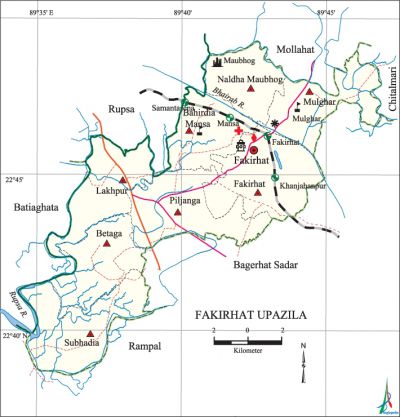Fakirhat Upazila
Fakirhat Upazila (bagerhat district) area 160.68 sq km, located in between 22°39' and 22°49' north latitudes and in between 89°34' and 89°47' east longitudes. It is bounded by rupsa and mollahat upazilas on the north, rampal upazila on the south, bagerhat sadar and chitalmari upazilas on the east, batiaghata and Rupsa upazilas on the west.
Population Total 134418; male 69327, female 65091; Muslim 98542, Hindu 35797, Buddhist 44 and others 35.
Water bodies Main rivers: Rupsa, bhairab.
Administration Fakirhat Thana was formed on 7 June 1869 and it was turned into an upazila on 1 August 1983.
| Upazila | ||||||||
| Municipality | Union | Mouza | Village | Population | Density (per sq km) | Literacy rate (%) | ||
| Urban | Rural | Urban | Rural | |||||
|
- |
8 |
67 |
87 |
27520 |
106898 |
837 |
62.4 |
57.9 |
| Upazila Town | ||||||||
|
Area (sq km) |
Mouza |
Population |
Density (per sq km) |
Literacy rate (%) | ||||
|
22.51 |
8 |
27520 |
1222 |
67.8 | ||||
| Union | ||||
| Name of union and GO code | Area (acre) | Population | Literacy rate (%) | |
| Male | Female | |||
|
Naldha Maubhog 63 |
3639 |
8335 |
7904 |
53.97 |
|
Piljanga 73 |
5740 |
8848 |
8379 |
60.40 |
|
Fakirhat 31 |
6279 |
12687 |
11714 |
63.03 |
|
Bahirdia Mansa 10 |
3923 |
7365 |
7003 |
61.01 |
|
Betaga 21 |
4556 |
6520 |
6310 |
60.59 |
|
Mulghar 52 |
4503 |
8651 |
7828 |
57.87 |
|
Lakhpur 42 |
4578 |
9653 |
9187 |
55.73 |
|
Subhadia 84 |
5930 |
7268 |
6766 |
56.11 |
Source Bangladesh Population Census 2001, Bangladesh Bureau of Statistics.

Archaeological heritage and relics Shiva Mandir, Khanjahania Mosque, Noapara Ghosh Zamindar Bari.
History of the War of Liberation During the war of liberation, the Razakars made a surprise attack on the camp of the freedom fighters at village Deyapara of Subhadia union in which many people from both sides were killed and wounded. On 6 May the Razakars of the upazila set many shops of Singati and Bahirdia bazars on fire. The Pak army, in collaboration with the local Razakars, brutally killed 9 innocent persons at Mansa of Bahirdia Mansa union on 25 August 1971.
Marks of War of Liberation Memorial monument 3, memorial sculpture 1.
Religious institutions Mosque 175, temple 67, sacred place 1. Noted religious institutions: Subhadia Takiabati Jami Mosque and Lalchandrapur' Khajahania Mosque.
Literacy rate and educational institutions Average literacy 58.8%; male 62.4%, female 55%. Educational institutions: college 4, technical college 2, secondary school 35, primary school 79, madrasa 25. Noted educational institutions: Kazi Azhar Ali College (1962), Shaheed Smriti Degree College (1993), Sheikh Hasina Technical College (1998), Mulghar Government High School (1857), Bahirdia High School (1892), Naldha Secondary School (1895), Karamatia Senior Madrasa (1957).
Cultural organisations Library 2, club 25, cinema hall 1, women's organisation 30.
Main sources of income Agriculture 53.63%, non-agricultural labourer 4.49%, industry 1%, commerce 18.43%, transport and communication 4.95%, service 9.02%, construction 1.46%, religious service 0.25%, rent and remittance 0.27% and others 6.50%.
Ownership of agricultural land Landowner 62.47%, landless 37.53%; agricultural landowner: urban 49.76% and rural 65.67%.'
Main crops Paddy, jute, potato, betel leaf, vegetables.
Extinct or nearly extinct crops Mustard, sweet potato, pulse.
Main fruits Coconut, mango, jackfruit, betel nut, banana.
Fisheries, dairies and poultries Fishery 8779 (including shrimp cultivation), dairy 33, poultry 47.
Communication facilities Pucca road 202 km, semi-pucca road 14 km, mud road 510 km.
Extinct or nearly extinct traditional transport Bullock cart, palanquin.
Noted manufactories Oil mill, rice mill, saw mill, ice factory, brick field, frozen shrimp preservation centre.
Cottage industries Weaving, potteries, bamboo work, cane work.
Hats, bazars and fairs Hats and bazars are 9, fairs 6, most noted of which are Fakirhat, Lakhpur Hat, Betaga Bazar and Atraka Baishakhi Mela are notable.
Main exports Coconut, betel nut, betel leaf, fish.
Access to electricity All the unions of the upazila are under rural electrification net-work. However 31.10% of the dwelling households have access to electricity.
Sources of drinking water Tube-well 94.59%, pond 1.64%, tap 0.94% and others 2.83%.
Sanitation 44.83% (rural 56.80% and urban 41.82%) of dwelling households of the upazila use sanitary latrines and 47.75% (rural 37.34% and urban 50.36%) of dwelling households use non-sanitary latrines; 7.42% of households do not have latrine facilities.
Health centres Upazila health complex 1, family planning centre 8, satellite clinic 1, community clinic 7, clinic 6.
NGO activities asa, brac, CARE, Prodipan. [Parthadev Shaha]
References Bangladesh Population Census 2001, Bangladesh Bureau of Statistics; Cultural survey report of Fakirhat Upazila 2007.
